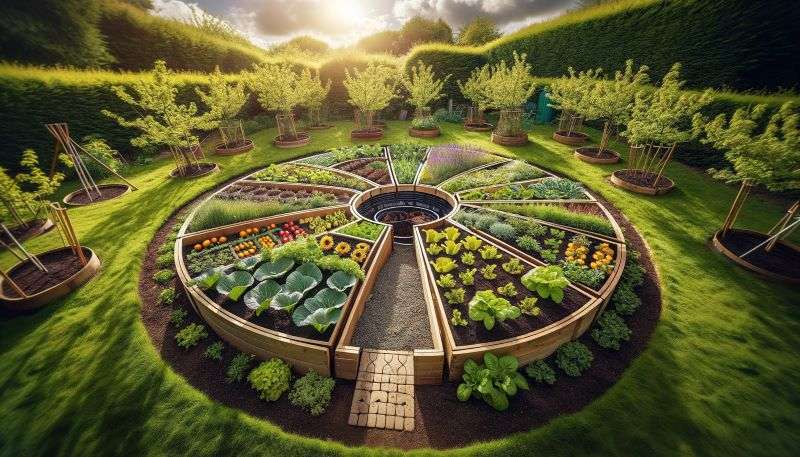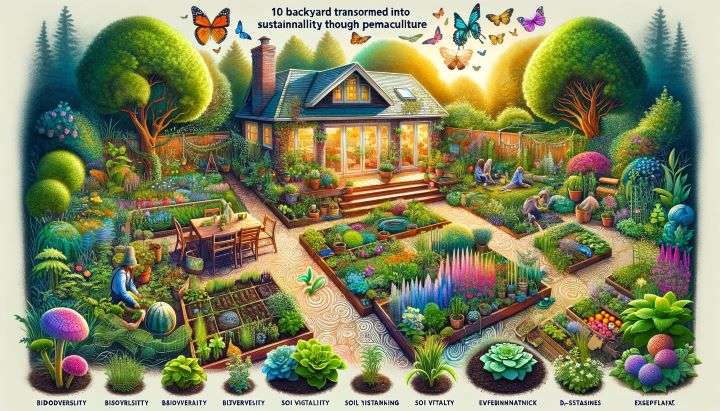This post contains affiliate links, through which we may earn a commission at no additional cost to you.
Table of Contents
Introduction
Ever dream of a backyard oasis that explodes with color, taste, and, uh, eco-friendliness? Wow, then you’re in for something good! With this guide, we’re about to reveal how to transform an ordinary backyard into a vibrant paradise through the charming concept of keyhole gardens. Let’s embark on an adventure! This will elevate your outdoor setup and make you a champion of sustainable gardening.
Paradise’s Peculiar Key: It’s called a “Keyhole Garden”?
Imagine a garden that goes beyond the ordinary, evolving into a sight for sore eyes and a functional marvel. This is what a keyhole garden embodies—a seamless fusion of beauty and practicality, all within the framework of an environmentally friendly and sustainable gardening practice. Characterized by its distinctive raised circular bed and a notch on one edge resembling a keyhole, this garden design isn’t merely about its innovative appearance. It stands as a beacon of a gardening ethos that places equal importance on the aesthetic appeal of a meticulously kept garden and its efficacy in cultivating a diverse range of plants, from vegetables and herbs to edible blossoms, conveniently within reach.
The novel configuration of a keyhole garden facilitates the optimal utilization of space and resources, presenting an optimal solution for gardeners aiming to increase their produce in a confined space. At the garden’s core lies the composting basket, which acts as the nucleus, converting kitchen leftovers and garden refuse into fertile compost, nourishing the garden while minimizing waste. This clever strategy of stacking soil and compost lays the groundwork for a thriving plant habitat, exemplifying an exemplary model of permaculture principles.
For those embarking on an exploration into keyhole gardening and the realm of edible landscapes, various enlightening books exist as precious tools, steering both beginners and experienced gardeners through the journey of erecting and maintaining these self-sustaining garden havens:
- “The Edible Front Yard: The Mow-Less, Grow-More Plan for a Beautiful, Bountiful Garden” by Ivette Soler – Soler’s pioneering gardening approach merges the functional aspects of edible plants with the aesthetic charm of decorative gardening, resonating perfectly with the ideology of keyhole gardens. The book outlines imaginative strategies for weaving edible plants into front yard designs, defying conventional standards and encouraging readers to perceive their gardening spaces in a new light.
- “Soiled Rotten: Keyhole Gardens All Year Round” by Deb Tolman, PhD. and G. Elaine Acker – Another fictional title for this scenario, this book would presumably offer expert advice on maintaining a keyhole garden through the seasons, ensuring a continuous supply of fresh vegetables, herbs, and flow.
- “Plant Your Garden In A Keyhole” by W. Leon Smith – Though a fictional title for the context of this discussion, if it existed, it would likely serve as a step-by-step guide to planning, constructing, and planting a keyhole garden, emphasizing the efficient use of space and resources to achieve a productive and beautiful garden. Ers, regardless of weather conditions.
- Edible Landscaping with a Permaculture Twist” by Michael Judd – Filled with hands-on advice, innovative solutions, and motivating instances of integrating food plants with nature, Judd’s book offers a captivating introduction to incorporating edible plants into one’s landscape, including a segment devoted to keyhole gardens.
- “The Vegetable Gardener’s Guide to Permaculture: Creating an Edible Ecosystem” by Christopher Shein-Shein introduces vegetable growers to permaculture gardening with insights and methods that align with the principles of keyhole gardening, focusing on sustainability and autosufficiency.
These books provide distinct viewpoints on the concepts underpinning keyhole gardening and edible landscaping, offering the necessary wisdom and motivation to embark on the fulfilling endeavor of cultivating a garden that is as visually appealing as it is fruitful. Through the content of these guides, gardeners can unearth the secrets to transforming their external spaces into verdant, sustainable, and edible havens.
Art of Garden Building
Conjuring a keyhole garden is a fun activity anyone can execute, even if the clouds are purple. Here’s you’re going to get a step-by-step method on how to construct a fresh keyhole garden:
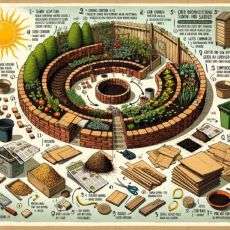
Step 1: Pick the Spot
Select a sunny location in your backyard chosen for the keyhole garden. It should get at least 6-8 hours of sunshine daily.
Step 2: Material Gathering
You have to get these materials:
- Bricks: stones, or timber for that circular raised bed.
- Cardboard or newspaper that we can use for weeding discouragement.
- Compost items like food remains, leaves, and grass cuttings.
- Soil mix: it’s a blend of garden earth, compost, and sand.
Step 3: Bed Construction
Build a circular bed that’s raised, about 6-8 feet wide and around 3 feet high, Do not forget to leave a gap in one side to make the keyhole design.
Step 4: Garden Layering
We must line the bed bottom with cardboard or newspaper – no weeds are allowed!
Step 5: Fill ‘er Up!
Now, it’s time to start filling the keyhole garden you have with composting materials and then your soil mixture. Layer them alternatively to create a growing environment full of nutrients.
Step 6: Keyhole Creation
Create a small composting basket in your garden’s keyhole center. This will serve as a strategic center for compost enriched with nutrients.
Step 7: Commence Your Garden
At this juncture, the adventure becomes truly thrilling; it’s time you have the privilege of selecting a wide variety of plants that align with your area’s climate and flavor preferences. Imagine strolling through your garden, enveloped by a spectrum of hues and scents, where distinctive flowers with their gentle blossoms provide visual delight and gastronomical joys. Indeed, we are discussing the edible flowers that can turn a basic salad into an exquisite dish or an ordinary drink into a lavish cocktail. But why limit ourselves?
Dive deeper into the world of herbs, those fragrant wonders that can transform your dishes from simple to sensational with just a dash. Rosemary, oregano, chives, and Basil are a few of the vast options available. These plants fulfill dual roles: they delight both the eyes and the taste buds and flourish in an extensive range of climates, making them attainable for beginners and seasoned gardeners.
Then, there’s the vegetables – the foundation of every edible garden. The options are genuinely boundless, from a cucumber’s crisp, cool crunch to the earthy sweetness of a freshly plucked carrot. Imagine the joy of picking your asparagus, eggplant, and zucchini, aware that your lovely mother will adorn the dining table with food that is as healthy as it is tasty. Your garden can mirror your culinary desires and ecological principles. It can vary from the exotic, with plants such as artichokes and kohlrabi, to the homely comfort of lettuce and green beans.
Every plant you choose carries with it a promise of abundance and allure, and the act of selection becomes an exploration of the vast, diverse world of botany tailored to your surroundings and tastes. This selection process is about functionality and crafting a space that excites the senses, promotes the local ecosystem, and generates joy through both the gardening process and the dining experiences. Thus, embark on this journey with passion and curiosity, and observe as your garden becomes a celebration of the infinite potentialities of nature.
Plants Flourishing in a Keyhole Garden
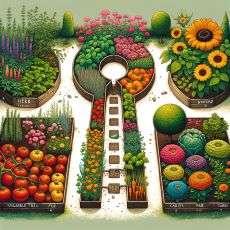
Let’s delve deeper into the plant species that flourish in gardens:
- Herbs On Top – Keyhole Garden is a suitable environment for nurturing your own herb sanctuary. Tarragon, parsley, cilantro, thyme, and peppermint do well in their well-drained, nutrient-packed soil.
- Vegetable Excitement – Grow your cherished vegetables in abundance! Tomatoes, peppers, carrots, and kale. All these botanical creations love the condition of keyhole gardens.
- Flower along the Spectrum – Breathe vibrant life into your garden with old-school flowers like marigolds, zinnias, and sunflowers, attract cute pollinators and, well, add a hint of whimsy!
- Fruitful Experience – Hey, don’t leave out the fruit trees! Dwarf sizes of apple trees pear trees, and cherry trees mesh perfectly with a well-tended keyhole garden.
Garden Care: A Magical Experience
Once your keyhole garden is bursting with life, we must ensure it stays that way season after season; here’s some help: a few maintenance tips to assist you in maintaining that garden beautiful,
- Watering: Always keep the soil just enough hydrated, especially for scorching weather periods,
- Mulching: Apply an organic mulch layer to hold moisture, keep the weeds down, and regulate soil temperature.
- Composting: The compost pile needs fresh kitchen waste regularly to feed your garden’s soil health.
- Pruning and Weeding: Trim the overgrowth and uproot the weeds; routine maintenance keeps up appearances.
- Beware of Pests: Duck! Pests are around and can be controlled with suitable actions.
Planting Guides, Recipes, DIY Products and Essential Buys
Creating a keyhole garden is an efficient and sustainable way to grow various plants in a limited space. It offers fresh vegetables, herbs, edible flowers, and fruits at your doorstep. Here’s a comprehensive guide to setting up your keyhole garden and creative ideas for using your harvest in the kitchen and for DIY projects.
Keyhole Garden Planting Arrangement
A keyhole garden is designed to maximize space and accessibility. Imagine a circle divided into wedges, with a keyhole-shaped path allowing easy access to the center where a composting basket sits. This design enables nutrients to flow directly to the plants. Here’s a suggested planting arrangement:
Vegetables
- Carrots – Plant in the outermost ring where the soil is deep.
- Lettuce – Opt for a mid-ring location; it requires less depth but enjoys excellent soil.
- Spinach – Another mid-ring choice, benefiting from the same conditions as lettuce.
- Tomatoes (dwarf varieties) – Plant near the center to support their taller growth and need more nutrients.
- Peppers – Side by side with tomatoes; they have similar requirements.
- Radishes – Outer ring, perfect for quick harvesting.
- Cucumbers (bush varieties)-They are near the center, where they can sprawl a bit without overtaking smaller plants.
Herbs
- Basil – They complement each other in growth and flavor near your tomatoes.
- Parsley – Mid-ring, it’s hardy and can grow in partial shade.
- Mint – Potted and positioned freely within the garden to control its spread.
- Thyme – Outer ring, requires less water, loves the sun.
- Rosemary – Near the edge, can grow large and needs less frequent watering.
- Chives – Mid-ring, they’re hardy and can provide ground cover.
- Oregano – Alongside thyme, as it enjoys similar growing conditions.
Edible Flowers
- Nasturtiums – Outer edges, their trailing vines can hang over the sides.
- Marigolds – Throughout, to deter pests.
- Calendula – Mid-ring, for its medicinal properties and beauty.
- Violas – Outer, adding color and are cold-tolerant.
- Borage – Central, as it can grow quite tall and is a great bee attractor.
- Lavender – Near the edges, for its scent and to deter rabbits.
- Chamomile – Spread out, it’s easy to grow and harvest for tea.
Dwarf Fruit Trees
- Dwarf Lemon – In a sunny spot, possibly outside the keyhole, if space is limited.
- Dwarf Apple – Central, provided there’s enough depth for roots.
- Dwarf Pear – Next to Apple, there are similar requirements.
- Dwarf Cherry requires a bit more sun, so place accordingly.
- Dwarf Peach – Warm, sunny spot to thrive.
- Dwarf Plum – Alongside peach, ensure well-drained soil.
- Dwarf Apricot – Needs plenty of sunlight, similar care to peach and plum.
Food Recipes from the Garden
- Tomato Basil Pasta
- Ingredients: Fresh tomatoes and basil from the garden, garlic, olive oil, salt, pasta.
- Instructions: Sauté chopped tomatoes, minced garlic, and basil in olive oil. Season with salt. Toss with cooked pasta.
- Lavender Lemonade
- Ingredients: Lavender flowers, lemons, water, sugar/honey.
- Instructions: Infuse water with lavender flowers and sweeten with sugar/honey. Add lemon juice and chill.
- Stuffed Bell Peppers
- Ingredients: Bell peppers, ground meat or a vegetarian substitute, tomatoes, onions, garlic, and herbs.
- Instructions: Hollow out peppers. Sauté onions, garlic, chopped tomatoes, and meat. Fill peppers and bake.
- Spinach and Cheese Quiche
- Ingredients: Spinach, eggs, cheese, cream, pastry crust.
- Instructions: Pre-bake crust. Mix eggs, cream, cheese, and steamed spinach.Transfer the mixture into the crust and bake until firm.
- Fresh Fruit Salad
- Ingredients: Various dwarf fruit tree produce, honey, and mint.
- Instructions: Cube and mix fruits. Drizzle with honey and garnish with mint.
DIY Garden Produce
- Herb-infused Oils
- Method: Dry herbs like rosemary or thyme, then immerse in oil.
- Use: Cooking or as a base for dressings.
- Dried Chili Flakes
- Method: Dry peppers, then grind.
- Use: Seasoning.
- Frozen Berry Mix
- Method: Freeze berries on a tray, then bag up.
- Use: Smoothies or desserts.
- Tomato Sauce
- Method: Cook down tomatoes with herbs, then can.
- Use: Pasta sauce base.
- Pickled Radishes
- Method: Slice radishes pickle in vinegar, sugar, and salt.
- Use: Sandwiches or salads.
Suggested Products to Buy
- Ultimate X23—Heavy Duty Multifunction (23-in-1) Shovel V2: This tool is essential for preparing and maintaining garden beds. The Multifunctional Folding Shovel boasts a versatile 180° foldable shovel head, making it ideal for various activities such as shoveling, digging, hoeing, and chopping. And because it’s so sturdy and easy to use, you’ll be able to get the job done in no time at all.
- The Medicinal Garden Kit: A selection of seeds for growing plants with health benefits, complementing your keyhole garden’s herb section. Incorporating a medicinal herb into your garden introduces fresh and fascinating dimensions to your botanical haven. In a crisis, people will again turn to plants for food and medicine. Some plants may disappear faster than others. The only way to ensure you have them when you need them is to grow them in your own backyard. Grab your Medicinal Garden Kit now and start growing!
- Dwarf Fruit Tree Fertilizer: Specially formulated to meet the nutritional needs of your dwarf fruit trees.
- Compost Bin: To create nutrient-rich compost from kitchen and garden waste, perfect for enriching the soil in your keyhole garden.
- Watering System: A drip irrigation kit or soaker hoses to ensure efficient water use and keep your plants hydrated without overwatering.
By carefully planning your keyhole garden and incorporating these planting arrangements, you’ll enjoy a bountiful harvest that supports a range of delicious recipes, practical DIY projects, and effective preservation methods. Remember to enhance your gardening experience with the recommended online products, which will help ensure your garden is productive, sustainable, and enjoyable.
You’ve Been Dreaming of This Paradise!
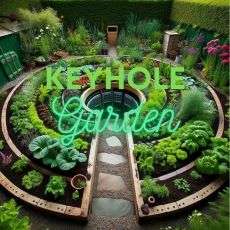
So, to summarize, the birth of a keyhole garden is your golden ticket to morphing your backyard into a land of natural beauty and bounty. Follow the method mentioned in this guide and pick the correct plants, and you’ll be on the right path to a prosperous, sustainable garden paradise. Plus, its unique design allows your garden to become a topic of amazing and inspired conversations for anyone who graces your outdoor space.
Hence, procrastinate no more. Grab your garden implements, and let’s get building your dream keyhole garden. Transform your backyard into a stunning sanctuary, watch it come alive, outshine your neighbors, and secure its position as the greatest backyard paradise in your community.
What makes keyhole gardens so productive?
Keyhole gardens are remarkably effective due to their innovative integration of composting directly within the gardening space. This results in nutrient-rich soil and uses water very efficiently, which is especially beneficial in areas with limited moisture and space.
Are you caring for a keyhole garden?
To ensure a keyhole garden remains productive, consistently add leftovers from the kitchen and plant debris to the central composting area. Water should be applied through this basket to evenly disperse the nutrients, with occasional compost stirring to aid in decomposition.
How does a keyhole garden contribute to water conservation?
The central feature of a keyhole garden is its composting core, which serves as a hub for hydration and nutrients. By effectively retaining moisture, it minimizes the necessity for regular watering.
Does a keyhole garden work in any environment?
Although keyhole gardens are exceptionally well-suited for dry environments because of their efficient water use, they can be adjusted to thrive in various climates by selecting appropriate plants and altering watering schedules.
Can keyhole gardens be utilized throughout the entire year?
Keyhole gardens can be productive throughout the year in areas with mild winters. In places with more severe winters, modifications such as adding protective covers might be necessary to prolong the growing period.

